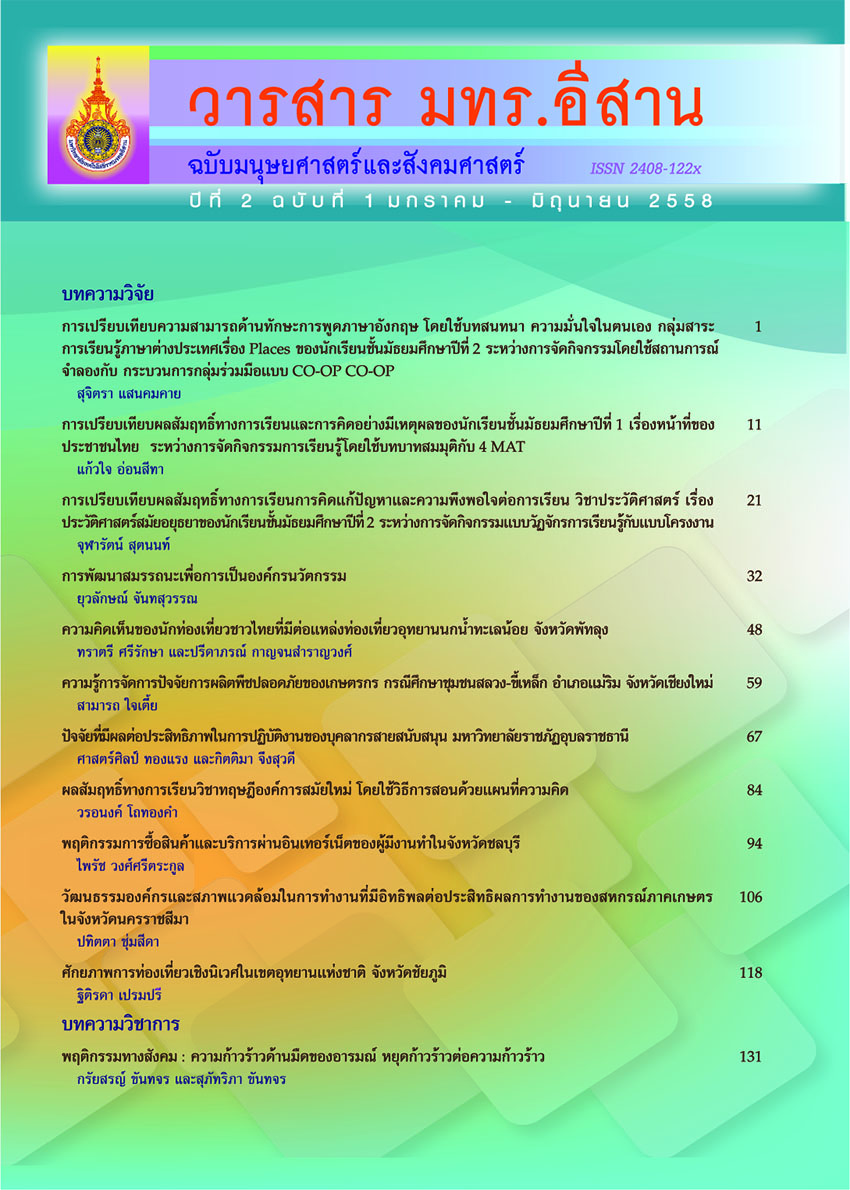A Comparisons of English Speaking Ability Using Conversation, Self - Confident Entitled “Places” in English of Matthayomsueksa 2 Students Between Situation Simulation and CO - OP CO - OP (Cooperative Learning) Approaches
Main Article Content
Abstract
The purposes of this research were to; (1) study the efficiency of learning activities; (2) study the effectiveness index of learning activities; (3) compare English speaking ability Using conversation, self - confidence of students between before and after learning; (4) compare English speaking ability using conversation, self - confidence of MatthayomSuksa 2 students between using Situation Simulation and CO - OP CO - OP (Cooperative Learning) approaches. The sample were used 80 Matthayomsuksa 2 students of U - Thain Pattana School at the first semester in academic year 2013. The samples were using cluster random sampling. The tools used consisted of lesson plans of Situation Simulation and CO - OP CO - OP (Cooperative Learning) approaches for eight plans include sixteen hour, English Speaking ability test for 4 options 40 items with the difficulty powers (p) ranging 0.20 to 0.75, discriminating powers (B) from 0.58 to 0.85, and the reliability of 0.93 and self - confidence test for five - rating scale 10 items; The statistics used to data analysis the data were percentage, mean, standard deviation and t-test (Independent Samples)
The results were as follows
1. The efficiency of Simulation and CO - OP CO - OP (Cooperative Learning) Approaches were 84.97/85.28 and 71.81/72.42
2. The effectiveness index of Simulation and CO - OP CO - OP (Cooperative Learning) Approaches were 0.795 and 0.612
3. The English speaking abilities and Self - confidence of Situation Simulation and CO - OP CO - OP (Cooperative Learning) approaches after learning were higher than those of before learning at 0.01 level of significance.
4. The Situation Simulation was higher than CO - OP CO - OP (Cooperative Learning) approaches at 0.01 level of significance.
Article Details
บทความที่ได้รับการตีพิมพ์เป็นลิขสิทธิ์ของมหาวิทยาลัยเทคโนโลยีราชมงคลอีสาน
ข้อความที่ปรากฏในบทความแต่ละเรื่องในวารสารวิชาการเล่มนี้เป็นความคิดเห็นส่วนตัวของผู้เขียนแต่ละท่านไม่เกี่ยวข้องกับมหาวิทยาลัยเทคโนโลยีราชมงคลอีสานและคณาจารย์ท่านอื่นๆในมหาวิทยาลัยฯ แต่อย่างใด ความรับผิดชอบองค์ประกอบทั้งหมดของบทความแต่ละเรื่องเป็นของผู้เขียนแต่ละท่าน หากมีความผิดพลาดใดๆ ผู้เขียนแต่ละท่านจะรับผิดชอบบทความของตนเองแต่ผู้เดียว
References
บวรจิต พลขันธ์. (2551). การพัฒนาทักษะการพูดภาษาอังกฤษของนักเรียนขั้นมัธยมศึกษาปีที่ 2 โดยใช้สถานการณ์จำลอง. วิทยานิพนธ์ กศ.ม. มหาสารคาม : มหาวิทยาลัยมหาสารคาม
พรทิพย์ โสรถาวร. (2550). การศึกษาเปรียบเทียบผลของการใช้กิจกรรมกลุ่มกับสถานการณ์จำลอง ในการพัฒนาเชาว์อารมณ์ของนักเรียนขั้นมัธยมศึกษาปีที่ 3. วิทยานิพนธ์ กศ.ม. มหาสารคาม : มหาวิทยาลัยมหาสารคาม
สุภัทรา อักษรานุเคราะห์. (2540). การสอนทักษะภาษาอังกฤษ. กรุงเทพฯ : โรงพิมพ์แห่งจุฬาลงกรณ์มหาวิทยาลัย
อภิษฎา ดวงจันทร์. (2551). การเปรียบเทียบผลของการใช้สถานการณ์จาลองและการเสริมแรงทางบวกที่มีต่อความเฉลียวฉลาดทางอารมณ์ของนักเรียนขั้นมัธยมศึกษาปีที่ 2 โรงเรียนเศวตฉัตร เขตคลองสาน กรุงเทพมหานคร. ปริญญานิพนธ์ กศ.ม. กรุงเทพฯ : มหาวิทยาลัยศรีนครินทรวิโรฒประสานมิตร
Chambers, Jay G. (1980). The Development of a Cost of Education Index : Some Empirical Estimatesand Policy Issues. Journal of Education Finance. Vol. 5. No. 3. p. 262
Geller, Danial M. (2010). Involvement in Role Playing Simulation; A Demonstration WithStudies on Obedience. Journal of Personality and Social Psychology. Vol. 5. No. 16 pp. 219-235
Trickett, Susan Bell. (2004). Movies-in-the-Mind : The Instantiation and Use of Conceptual Simulations in Scientific Reasoning. Dissertation Abstracts International. Vol. 64. No. 10 pp. 5250-B
Snyder, Lisa Marie. (2003). The Design and Use of Experiential Instructional Technology for theTeaching of Architectural History in American Undergraduate Architecture Programs. Dissertation Abstracts International. Vol. 64. No. 4 p. 1109-A


